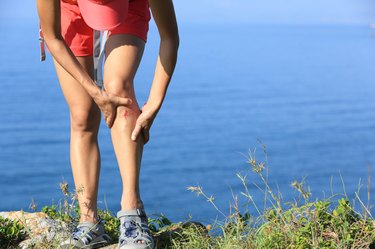
Calf and knee pain can be debilitating and force you to take time out from your exercise or sports training. Such pain may prevent you from completing your everyday activities such as getting out of bed and walking around your house. Include exercises to strengthen your hamstring, quadricep and calf muscles, all of which cross your knee joint, reducing your risk of calf and knee injuries.
Types
Video of the Day
Pain in the calf and knee may result from a muscle strain or inflamed tendon of the hamstring muscles where they insert just below the knee. Pain may also be caused by a cyst in the cavity behind the knee, lying under the gastrocnemius muscle. A direct hit or severe cold from an ice-pack may injure the peroneal nerve as it wraps around the posterior and lateral aspects of the knee, just below the knee joint, according to Sandra Shultz and colleagues in their book, "Examination of Musculoskeletal Injuries."
Video of the Day
Identification
Pain from a hamstring muscle sprain or inflamed tendon may be immediately felt if it is a severe partial or complete tear such as during a sprint. Redness, swelling and bruising behind and just below the knee, spreading toward the calf are also indications of a hamstring injury. If you have a fluid-filled bulge, along with tenderness and swelling behind your knee and calf, it may be a popliteal cyst, reports Shultz and colleagues. This cyst results from synovial fluid accumulation and the distension of the synovial cavity of the knee joint toward the back of the knee. Symptoms of a peroneal nerve injury include tingling, numbness or burning sensations down the sides of the calf to the bottom of the foot.
Effects
Knee and calf pain limits range of motion at the joint. It also decreases your ability to support and stabilize your body in a standing position. If you are an athlete or exercise enthusiast, especially if you are working on performance goals, pain in your leg forces you to halt your activity, compromising your performance.
Treatments
Typical treatment for hamstring injuries is to halt activity, apply ice three times a day for three days at 20 minutes per ice application, according to the American Red Cross. Take anti-inflammatory medicine within the first few days to help reduce pain and swelling, according to the National Institutes of Health. Seek advanced medical care from your doctor or physical therapist if you think you have a popliteal cyst or an injury to your peroneal nerve.
Prevention
Eccentric hamstring exercises, where your hamstring muscle is contracting but lengthening, have been shown to increase the length in which tension/force is developed across your hamstrings. Include eccentric exercises as part of your training routine to reduce your risk of hamstring injuries and increases your rate of recovery from a hamstring injury, according to a 2008 article by Matt Brughelli and John Cronin, Ph.D., published by the National Strength and Conditioning Association. Strengthen the muscles and ligaments surrounding your knees to reduce your risk of knee injury and therefore reduce your risks of developing a popliteal cycst. Use a barrier between your skin and the ice-pack if you must ice behind your knee and along your calf to reduce injury to your peroneal nerve.
Is this an emergency? If you are experiencing serious medical symptoms, please see the National Library of Medicine’s list of signs you need emergency medical attention or call 911.